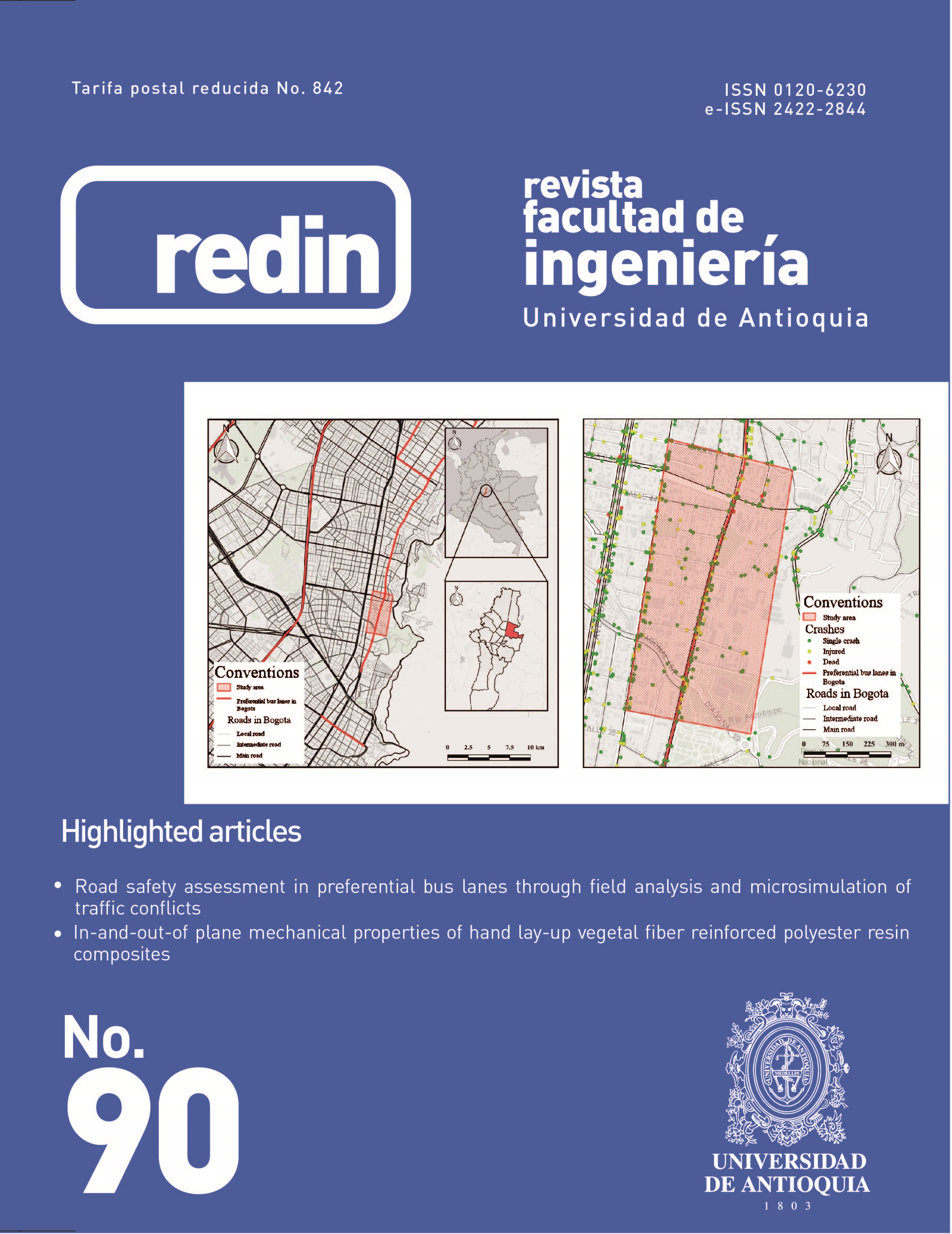Perception about the use of monitoring systems in civil construction structures
DOI:
https://doi.org/10.17533/udea.redin.n90a05Keywords:
sensors, monitoring, reinforced concrete structure, buildingsAbstract
In recent years, concrete structures have started to show increased amounts of degradation or damage. This phenomenon is generally caused by the growth of these constructions, particularly with regard to slenderness. In the quest for new strategies to address this problem and to ensure the safety of structures and their occupants, tools for damage detection and timely analysis distributed within buildings have been developed. These tools are referred to as “Structural Health Monitoring” sensors. It is known that these systems still have high costs, thus this study aims to assess their value through future projections of their costs and utility. This monitoring method, although not widespread, mainly aims to maintain the integrity of major projects; it is not currently focused in small sized works, with the exception of a few structures of historical interest. Therefore, this study proposes the analysis of structural monitoring systems in civil construction, through means of a survey and interviews with experts. The study is aimed at investigating current technologies, planning for implementation, and identifying costs and feasibility of structural monitoring in the future. In conclusion, it was possible to expose that deformation and displacement sensors, along with optical and electrical technologies are the most commonly used types of sensors. Furthermore, it was found that monitoring systems are only feasible for large structures and the estimated time for use in medium-sized buildings is 15 years or more. However, it can be noted that the cost is currently very high, but will likely be reduced in the future.
Downloads
References
B. Glisic, L. J. Ming, N. C. Tat, D. Inaudi, and Y. T. Yew, “Large-scale lifespan monitoring of high-rise buildings using long-gauge fiber optic sensors,” in 3rd International Conference on Structural Health Monitoring of Intelligent Infrastructure, Columbia, Canadá, 2007, pp. 1–7.
A. Arêde, A. Costa, C. Costa, P. M. Costa, and C. Barbosa, “Monitorização do comportamento estrutural de uma ponte nova em arcos de alvenaria de pedra,” in 06 Congresso Nacional Mecânica Experimental, Zadar, Croatia, 2004, pp. 184–193.
R. G. de Andrade, “Monitoramento de curta duração de uma ponte curva em concreto armado: um estudo de caso.” M.S. thesis, Universidade Politécnica de São Paulo, São Paulo, Brasil, 2012.
A. BRASIL, Monitoreo en la Construcción Civil. Asociación Latinoamericana de Control de Calidad, Patología y Recuperación de la Construcción - ALCONPAT Int, 2013.
W. S. Assis, “Sistemas computacionais de apoio à monitoração de estruturas de engenharia civil,” PhD Thesis, Curso de Engenharia Civil, Universidade Politécnica de São Paulo, São Paulo, Brasil, 2007.
P. F. C. Antunes, “Sensores ópticos para monitorização dinâmica de estruturas,” Ph.D thesis, Departamento de Física, Universidade de Aveiro, Aveiro, Portugal, 2011.
B. Glišić, D. Inaudi, J. Lau, Y. Mok, and C. Ng, “Long-term monitoring of high-rise buildings using long-gage fiber optic sensors,” in 7th International conference on multi-purpose high-rise towers and tall buildings, Dubai, 2005, pp. 1–13.
T. J. Gordon, “The real-time delphi method: excerpt from futures research methodology,” Patent, 2008.
S. N. Yu, J. H. Jang, and C. S. Han, “Auto inspection system using a mobile robot for detecting concrete cracks in a tunnel,” Automation in Construction, vol. 16, no. 3, pp. 255–261, May. 2007.
M. Sarker, T. Ali, A. Abdelfatah, S. Yehia, and A. Elaksher, “A cost-effective method for crack detection and measurement on concrete surface,” ISPRS - International Archives of the Photogrammetry, Remote Sensing and Spatial Information Sciences, vol. XLII-2/W8, pp. 237–241, Nov. 2017.
X. Zhong, X. Peng, S. Yan, M. Shen, and Y. Zhai, “Assessment of the feasibility of detecting concrete cracks in images acquired by unmanned aerial vehicles,” Automation in Construction, vol. 89, pp. 49–57, May. 2018.
A. Mohan and S. Poobal, “Crack detection using image processing: A critical review and analysis,” Alexandria Engineering Journal, vol. 57, no. 2, pp. 787–798, Jun. 2018.
Y. Zhang, T. Planès, E. Larose, and A. Obermann, “Diffuse ultrasound monitoring of stress and damage development on large scale concrete structures,” The Journal of the Acoustical Society of America, vol. 141, no. 5, pp. 3831–3831, 2017.
Published
How to Cite
Issue
Section
License
Copyright (c) 2019 Revista Facultad de Ingeniería Universidad de Antioquia

This work is licensed under a Creative Commons Attribution-NonCommercial-ShareAlike 4.0 International License.
Revista Facultad de Ingeniería, Universidad de Antioquia is licensed under the Creative Commons Attribution BY-NC-SA 4.0 license. https://creativecommons.org/licenses/by-nc-sa/4.0/deed.en
You are free to:
Share — copy and redistribute the material in any medium or format
Adapt — remix, transform, and build upon the material
Under the following terms:
Attribution — You must give appropriate credit, provide a link to the license, and indicate if changes were made. You may do so in any reasonable manner, but not in any way that suggests the licensor endorses you or your use.
NonCommercial — You may not use the material for commercial purposes.
ShareAlike — If you remix, transform, or build upon the material, you must distribute your contributions under the same license as the original.
The material published in the journal can be distributed, copied and exhibited by third parties if the respective credits are given to the journal. No commercial benefit can be obtained and derivative works must be under the same license terms as the original work.










 Twitter
Twitter